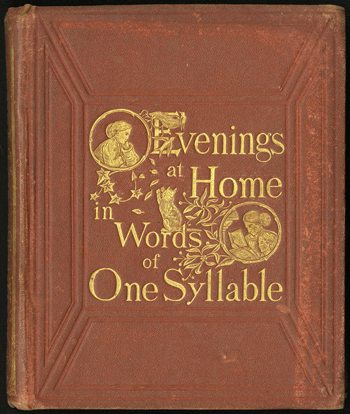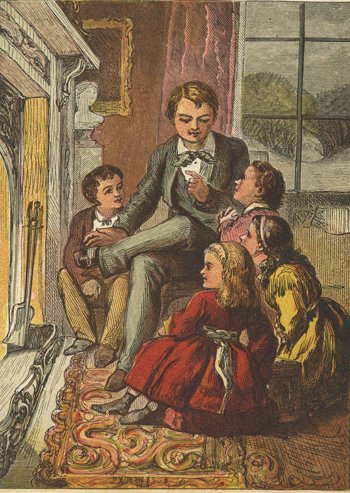

Evenings at Home: In Words of One Syllable by Lucy Aikin (1868)

Evenings at Home: In Words of One Syllable by English author Lucy Aikin (1781-1864, pen name Mary Godolphin) is a collection of 31 children’s stories published by George Routledge and Sons in the United Kingdom, and American News Company in the United States, both books appearing in 1868. Housed in the de Grummond archives, the New York edition consists of 161 pages, its font sized to accommodate up to 21 lines of text per page. Evenings at Home is a product of the Golden Age of Children’s Literature (1860-1920), a time that saw such authors as Beatrix Potter, J.M. Barrie, Jules Verne, and Frank L. Baum creating some of young people’s best-known books. What sets Aikin apart from her contemporaries is the fact that, true to the work’s title, each story is told in a unit of writing no longer than one syllable. This is an ideal allotment for young people on the threshold of mastering literacy, yet it poses a challenge for the author’s vocabulary, along with the rhythmic pacing of words (and corresponding sounds) that cannot exceed their single-syllable constraint. Aikin breaks her rule, however, in Night 23’s “King Alfred the Great,” history leaving her no choice, as this is the Wessex king who repelled Viking hordes during the Battle of Edington in 878.
Evening’s preface tells us that a Mr. and Mrs. Howe, residents of “a fine old house, not far from a small town,” continue their children’s school lessons at home where a revolving door of guests contribute stories to assist their teaching efforts. The guests’ stories are kept in a box that the children retrieve on their return from school, its contents read aloud over the course of 31 nights. The majority of its stories feature animals given the gift of human speech. Titles include “The Ant’s Tour,” “The Young Mouse,” “The Rat With a Bell,” and “The Hog Who Speaks His Mind” (“’Tis plain that the best price must be set on that beast who is kept for his own sake, and least for the work that may be got out of him.” 63). The stories range in size from one-and-a-half to six pages. One of the longer stories, Night 5’s “What’s In a Name?,” eschews animal speakers for people, its central character Jack Yarn telling us customs from a faraway land:
Evenings at Home was illustrated by the German artist Joseph Martin Kronheim (1810-1896). Spread throughout the book, his eight drawings range from the domestic (listeners gathered around the hearth) and mischievous (a boy harassing geese) to the lower-stationed going about their daily lives (a squire collects wood, places it into a basket atop his foal; a maid tends to a milk-drenched cat). Each illustration features some aspect of the sky, whether directly overhead or seen through a window. Visible sky was a key trait of landscape painting, a style of art dating back to the medieval era, still in vogue during Kronheim’s life.

Though a total of seven In Words of One Syllable Books bearing Aikin’s pen name were published between 1867 and 1870 (versions of Robinson Crusoe and The Pilgrim’s Progress among them), her literary foothold rests in translations of French texts, in addition to biographies of Joseph Addison and Anne Boleyn. She died childless, her niece Anna Letitia Le Breton managing her estate. Interestingly, Aikin’s pen name is the same gender, which is somewhat uncharacteristic for female writers of this time. Godolphin has an entertaining ring to it; perhaps this was chosen as a way to distance Aikin’s legacy as a biographer of importance from her one- syllable projects. There was a Lady Mary Godolphin who died 17 years before Aikin’s birth, this Godolphin a relative of the political elite, though plagued by accusations of dubious parentage.
To view Evenings at Home: In Words of One Syllable, visit Special Collections in McCain Library 305. The book can be found in the de Grummond Children’s Literature Collection at PZ7 .G54376 Eve 1868. For more information about this book, contact Ellen Ruffin at Ellen.Ruffin@usm.edu or 601.266.6543, or view this item in its entirety at the University of Southern Mississippi Digital Collections
This edited text was written by Jonathan Riccio, graduate student at Southern Miss. This Item of the Month stems from the Digital Archives Research Group’s Save Our Stories project, a project designed to introduce Southern Miss students to our archival holdings. To learn more about SOS or the Digital Archives Research Group at USM, visit https://digitalarchives.wordpress.com. Congratulations to Jonathan Riccio on his strong work.